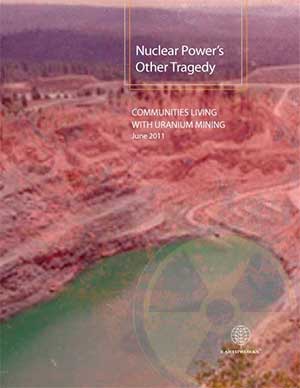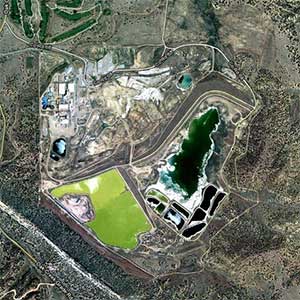Uranium mining case studies

These case studies are drawn from the Earthworks report:Nuclear Power's Other Tragedy: Communities Living with Uranium Mining
Nearly every uranium operation studied in this report had environmental and/or labor violations. The following case studies -- taken from our publication, Nuclear Power's Other Tragedy: Communities Living with Uranium Mining -- highlight some of the most controversial uranium projects in the United States.
Smith-Highland Ranch:
Wyoming’s “model” for ISL mining
Power Resources Corporation, owned by Cameco, owns and operates the Smith Ranch and Highland ISL facilities in Converse County, Wyoming. Together, the facilities form the largest uranium production facility in the United States.
In 2006, Cameco Corporation received certification under the ISO 14001:2004 program, one of the most internationally recognized standards for environmental management. The certificate was awarded to Cameco for its excellence in environmental protection and implementation of “best practice” environmental management system at its Smith-Highland facilities.[1]
Just over a year later, the Wyoming DEQ slammed Smith-Highland Ranch with several environmental violations.
Location of the Smith-Highland operations. View as a larger map
- A DEQ investigation in the fall of 2007 revealed that the Smith-Highland ISL projects had “an inordinate” number of spills, leaks, and other releases. According to the WDEQ documents there were over 80 spills reported. Of the 202,247 gallons of mining fluid spilled, only 3,500 gallons were recovered.[2]
- Other violations included delayed restoration of groundwater, “routine” spills, and a bond inadequate to cover restoration costs.
- Power Resources Corporation routinely violated DEQ laws directing underground water restoration to occur simultaneously with ongoing production.[3]
- The cleanup efforts had suffered due to inadequate staffing, high turnover, and lack of corporate commitment.
In July 2008, Cameco agreed to pay a total of $1.4 million in fees to the WDEQ and state for the numerous violations.[4]
The Smith-Highland Ranch is not only an example of the potential environmental hazards associated with ISL operations, but also the poor oversight of ISL projects in Wyoming. ISL production of uranium is the primary method of uranium extraction today, and the DEQ should have stronger oversight over these operations.
Lincoln Park/Cotter Mill:
Canon City's Superfund site

Cotter Mill Superfund site. Note the golf course immediately
to the north. Photo: Google Maps
The Canon City Mill site located just outside of Canon City, Colorado is owned and operated by Cotter Corporation, a Colorado based uranium mining group.
The mill operated continuously from 1958 until 1979, and has operated intermittently since that time.
Before 1980, Cotter Corporation disposed of tailings and other wastes from uranium processing into unlined bonds. Contaminants such as molybdenum, uranium, and uranium daughter products leached into the groundwater and migrated to Lincoln Park and nearby local wells.[5]
As a result of high contamination levels, the US EPA placed the Cotter mill on the Superfund National Priorities List in 1984.
Since decommissioning and reclamation efforts at the mill began, Cotter Corporation has been cited for numerous labor and environmental violations and has continuously shown negligence of EPA standards and requirements.
Among the several labor violations and contamination spills, Cotter Corporation pleaded guilty in March 2008 for its role in the poisoning deaths of migratory birds at the mill. Approximately 40 geese were killed after coming into contact with the solvent in the pond.
Previously stating that the mill would eventually reopen, in September 2010, Cotter made a statement telling regulators they would discontinue testing radon emissions on the site because it is no longer an active facility subject to regulation.[6]
The battle continues, as many environmental groups question Cotter Corporation’s commitment to environmental protection. A citizens group filed a lawsuit in September 2010 accusing Colorado regulators of failing to require Cotter Corp. to set aside enough money to clean up its uranium mill in Canon city. The department estimated costs of at least $43 million, while Cotter set aside only $20.2 million.[7]
The Schwartzwalder Mine:
Cotter Corp. vs. Colorado Mined Lands Reclamation Board
Location of the Schwartwalder uranium mine. View as a larger map.
Once one of the nation’s largest underground uranium mines, the Schwartzwalder Mine is located in Jefferson County northwest of Denver, Colorado.
Colorado Cotter Corporation acquired the Schwartzwalder Mine in 1965 and was operational until 2000. The uranium deposit was discovered in the 1940s and was developed as a multi-level, hard rock underground uranium mine.[8]
As a result of the drop in uranium prices in the past decade, Cotter Corporation shut down the Schwartzwalder Mine and started reclamation.
The Schwartzwalder Mine has faced many environmental issues since its closure. The Colorado Department of Public Health and Environment and Cotter Corporation have yet to settle on a plan for cleanup.
Today, groundwater near the Schwartzwalder Mine contains uranium levels that are 1,000 times higher than human health standards.
Since April 2010, Cotter has faced numerous state orders to pump and treat the toxic water that is filling the mine and allegedly contaminating nearby reservoirs. Ralston Creek, which flows into Denver Water’s Ralston Reservoir, contains uranium levels 310 ppb.
In August 2010, Cotter agreed to remove tainted water from its mine, but had chosen to pump and clean only surface ponds and not the water inside of the mineshafts.
Despite high uranium concentrations in nearby water resources, Cotter Corporation defied state orders to clean up the site and refused to pay state fines ($55,000) for failing to do so. Cotter Corporation claims that the mine water is not contaminating Ralston Creek, therefore has no obligation to pump and treat this water immediately.
The Schwartzwalder Mine has been in environmental non-compliance for 12 of the past 12 quarters. Concentration violations include uranium, boron, chromium, copper, cyanide, fluoride, zinc, thallium, radium 226, and radium 226 as well as several other environmental violations.
In October 2010, Cotter Corporation filed a lawsuit against Colorado’s Mined Lands and Reclamation Board for abusing its discretion when it ordered Cotter to pump out and treat uranium-tainted water. At issue is whether state regulators had enough evidence to order the cleanup and impose large fines against Cotter Corporation.[9]
As the legal battle continues between state departments and Cotter Corporation, water in the mining shaft still poses as a threat to water resources.[10]
The case at the Schwartzwalder mine has many environmental groups up in arms. “The mess at Schwartzwalder shows that Colorado isn’t ready for a new uranium boom,” spokesman Matt Garrington said. “We have abandoned and inactive uranium mines littered across the state that haven’t been cleanup up and are still causing environmental problems.”[11]
For more information:
Sources
- Cameco Corporation. Smith Ranch-Highland Uranium Mine Receives ISO 14001:2004 Certification. June 1, 2006. Accessed 10/28/10. http://www.cameco.com/media/news_releases/2006/?id=146
- Summary: Wyoming Department of Environmental Quality Notice of Violation to Power Resources, Inc. Prepared by Lilias Jarding Ph.D. http://www.nunnglow.com/documents/SUMMARY_OF_WY_NOTICE_OF_VIOLATION.pdf
- DEQ needs to ensure uranium mine oversight. Star-Tribune Editorial Board. April 08, 2008. Accessed 11/02/10. http://trib.com/news/opinion/editorial/article_e3143cb0-810d-5c74-98c0-04f8f1610f65.html
- “Uranium mine to pay $1.4 million settlement”. Star-Tribune. Dustin Bleizeffer. July 10, 2008. http://trib.com/news/breaking/article_2a6d1db9-1315-5cfa-9011-5aaffa009921.html
- US EPA Region 8: Superfund Lincoln Park Site. Accessed 11/04/10 http://www.epa.gov/region8/superfund/co/lincolnpark/
- Canon City Daily Record. Cotter to shut down mill. August 19, 2010. http://www.canoncitydailyrecord.com/Top-Story.asp?ID=14430
- Group sues over Cotter Corp. uranium mill cleanup. The Associated Press. Accessed 11/04/10. http://www.denverpost.com/news/ci_16143033?source=pkg
- Cotter Corporation: Uranium. Accessed 11/02/10. http://www.cotterusa.com/
- “Cotter sues state for abusing discretion by ordering uranium mine cleanup”. The Colorado Independent. By David O. Williams. October 07, 2010. Accessed 10/28/2010. http://coloradoindependent.com/63530/cotter-sues-state-for-abusing-discretion-by-ordering-uranium-mine-cleanup
- “Owner of uranium-tainted mine defies Colorado’s cleanup orders, fines.” Denver Post. By Bruce Finley. September 22, 2010. Accessed 10/28/2010. http://www.denverpost.com/news/ci_16129132
- “Defunct uranium mine contaminating groundwater near reservoir”. Denver Post. By Bruce Finley. April 16, 2010. Accessed 10/28/2010. http://www.denverpost.com/ci_14894696
Tagged with: uranium mining, smith-highland ranch, schwartzwalder, power resources, pollution, labor, cotter, canon city mill, cameco
Follow Earthworks